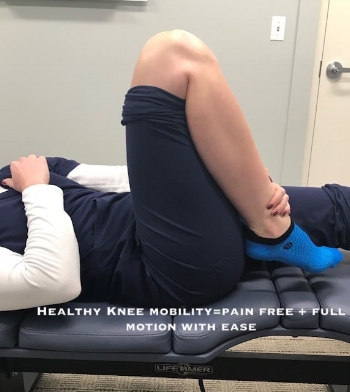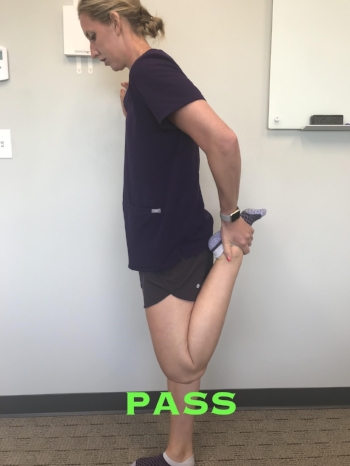Getting to Root Cause of Knee Pain to End It!
Did you know knee pain affects 25% of the adult US population? Did you also know that you don’t have to live with knee pain? Our goal is keeping patients active, healthy, and happy. One of the ways we do that is by fixing knee pain without drugs, injections, or surgery.
Here are the top three reasons why knee pain happens:
Overuse-related adhesion in the tissues around the knee is the primary cause. Soft tissue adhesions develop through overuse in athletics and repetitive bending. Over time adhesion slowly develops causing decreased flexibility, weakness, and pain.
Here is an at-home test you can do to see if your knee is healthy. Lie flat on your back, grab the front of your shin and pull your leg back. If the soft tissues are healthy, your heel will easily touch your buttocks. If it doesn’t touch or you have to crank as hard as you can, then adhesion is present.
Do you have knee pain and a limited test? Our doctors can help you get your life back and fix the problem! They are Integrative Diagnosis specialists which means they are experts at finding and fixing adhesion.
Meniscus tears can also cause knee pain. There are many different types of meniscus tears, but in general, they are either acute (it happens fast) or chronic (it happens gradually).
The meniscus is a thick piece of cartilage that acts as your knee shock absorbers. So it’s critical that it stays healthy your whole life.
The most common types of meniscus tears are the ones that happen gradually over time. You may notice your knee feels achy or stiff but only after certain activities or lots of kneeling. This is an early sign that the meniscus is starting to get worn down.
Our doctors have great success in helping patients recover from meniscus tears and most do not require surgery!
The last reason for knee pain should only occur much later in life. Folks in their 70’s and older will get osteoarthritis (OA) that is from general wear and tear.
But what happens when OA starts when you’re younger (60 and under)? This is a big deal because it can progressively worsen which means you lose the freedom to be active! Painful OA is also strongly associated with early onset and progression.
Our treatment approach is the ideal method to keep knee OA from progressing. You don’t have to live with the pain until a knee replacement is your only option.
The knee joint is a very vulnerable joint and should never be painful. The doctors at Functional Pain Relief have great success in helping you restore healthy knee motion, returning to activities you love, and preserving your freedom. Stay tuned for more information on what you can do to mitigate knee pain and how we fix knee pain in our clinic.
Now that you are aware of why knee pain happens, here are a few tips to avoid knee pain. It’s important to stress that knee pain is not normal and it’s a big deal. These steps will not fix pain but can help you manage it until action is taken to fix the problem.
Listen to your symptoms. There is no such thing as a “good pain” in regards to the knee. If you did a tough workout you would expect your muscles to be sore, but the knee shouldn’t be painful.
The first step is to avoid the offending activity for at least a few days to let the knee inflammation subside.
The longer symptoms are present the quicker your knee health will degrade.
If the activity that causes your knee pain is part of your work or an activity you love, then it’s time to get the problem solved.
Strengthen your glutes and hamstrings. The glute muscles are the muscles around your butt and the hamstrings are the muscles on the back of your thigh. This is collectively called your posterior chain.
Most people will try to focus on strengthening the quads, but this can lead to an imbalance which further puts the knee under more stress.
Muscular balance creates better knee stability and is a much healthier environment for the knee to function.
Bottom line--never skip leg day and be sure to do exercises for your glutes and hamstrings.
Avoid prolonged, deep flexion (knee fully bent). This is especially true if you have limited mobility in the knee.
First, see how well your knee can flex by trying this at-home test (see image). The heel should easily touch the butt with no pain. Using extra force doesn’t count. Did you pass that test?
The knee joint acts like a hinge so if a hinge is stuck, forcing it will only create more problems.
Take breaks while gardening, come out of the deep yoga positions a little earlier, take an extra rest day from heavy squats when needed.
If trying these steps isn’t helping then it’s time to consult with the doctors at Functional Pain Relief. Get rid of knee pain so you can do the activities you love.
If you have been following this blog series on knee pain, then you’ve seen the 3 most common reasons why knee pain happens and 3 steps to avoid knee pain. Are you someone reading this and suffering with knee pain? Well, you’re in luck--this blog is for you!
We use specific functional tests to determine the health of the knee and objectively measure progress. Here are the 3 most common adhesion treatments we do in our office to fix knee pain for good:
Instrument Adhesion Release (IAR) to the ligaments and meniscus is the first step to getting the knee healthy.
Adhesion acts like glue in the tissues making the knee less flexible and weaker. This causes increased stress to the joint and meniscus. Not good!
Fixing the adhesion allows the knee to move better, takes stress off the meniscus, saves the cartilage, and decreases the pain.
IAR to the patellar and quadriceps tendon is the next thing to fix knee pain.
Adhesion in the tendons will decrease knee function and increase knee pain.
More specifically, adhesion will lead to tendonitis, tendinosis, and cartilage damage behind the knee cap. That’s when the pain becomes more severe.
Fixing the adhesion in the tendon can reverse the tendon pain and prevent cartilage damage.
Manual Adhesion Release (MAR) to one of the quadriceps muscles called the Rectus Femoris.
The rectus femoris is a long muscle that crosses the hip and knee joint. Because it functions with two joints it takes a beating. This makes adhesion in this muscle extremely common so it’s critical to remove the adhesion completely to fix knee pain.
When adhesion is present it will cause tight quads and knee pain. This dramatically decreases function and performance!
Try this at-home test to see if you pass with a healthy quad. If you failed the test and you have knee pain or tight quads, then it’s time to see the adhesion specialists.
Are you still dealing with knee pain despite other treatments and time? Then it’s time to consult with the doctors at Functional Pain Relief. Let our doctors help you get back to the activities you love!







